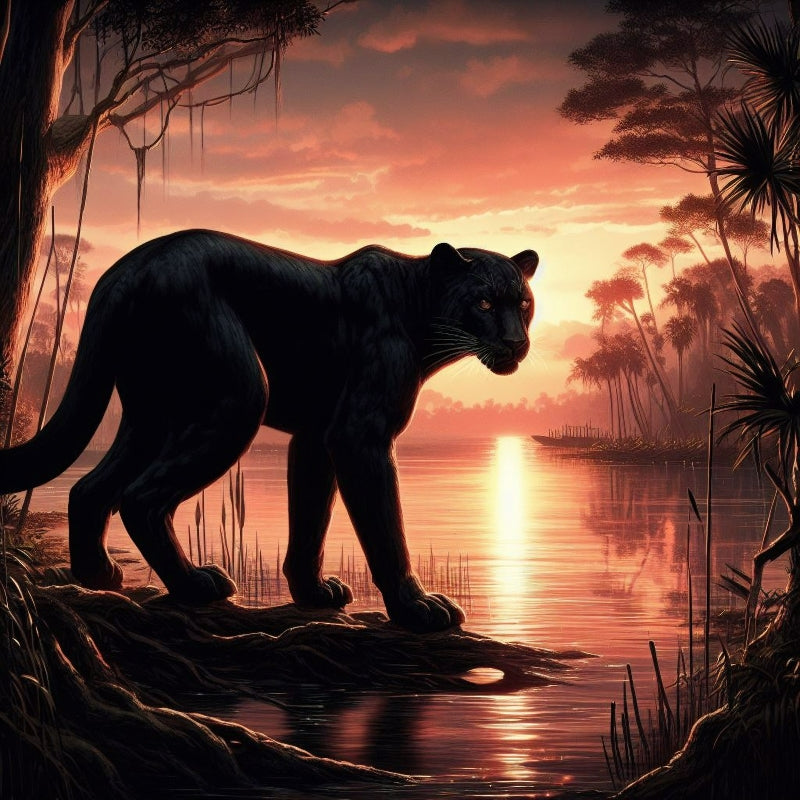
Top 10 Interesting Facts About Black Panthers
Share
Black panthers, often shrouded in mystery and allure, are a captivating subject of fascination for wildlife enthusiasts and casual observers alike. While the term "black panther" is commonly used to describe melanistic leopards (Panthera pardus) and jaguars (Panthera onca), these majestic creatures possess unique characteristics and behaviors that set them apart in the animal kingdom. Here are ten intriguing facts about black panthers, supported by scholarly articles and authoritative sources.
- Melanism Explained
Melanism is a genetic condition that results in an excess of dark pigmentation, giving black panthers their distinctive coat color. In leopards, this trait is caused by a recessive allele, while in jaguars, it is attributed to a dominant allele. Despite their dark appearance, the characteristic rosettes of their fur can still be seen under certain lighting conditions, highlighting their intriguing beauty 2 3.
- Habitat Preferences
Black panthers are primarily found in dense forests and tropical regions where their dark coloration provides excellent camouflage. They thrive in environments such as the rainforests of Central and South America for jaguars and the jungles of Africa and Asia for leopards. Their ability to blend into the shadows aids in hunting and evading predators 3 4.
- Rarity of Sightings
Black panthers are quite rare compared to their spotted counterparts. Studies suggest that melanism occurs in approximately 11% of leopard populations, making sightings of these elusive creatures particularly special. For instance, the recent confirmation of a black leopard in Kenya was notable as it had been over a century since one was last photographed in Africa 2 6.
- Behavioral Adaptations
The dark fur of black panthers provides excellent nighttime camouflage, aiding their nocturnal hunting habits. However, this adaptation may also impair visual communication with other cats due to reduced contrast against natural backgrounds. A study highlighted that while their coloration enhances stealth during night hunts, it might hinder social interactions among these solitary animals 4.
- Cultural Significance
Black panthers hold significant cultural importance across various societies. In many indigenous cultures, they are seen as symbols of power, mystery, and protection. Their representation in folklore and mythology underscores their status as revered creatures within the animal kingdom.
- Diet and Hunting Techniques
Like their spotted relatives, black panthers are carnivorous predators with a diet consisting primarily of ungulates, birds, and smaller mammals. They employ stealthy hunting techniques, using their keen senses to stalk prey before launching a powerful ambush. Their dark coats provide an advantage in low-light conditions, allowing them to approach unsuspecting animals more effectively 3.
- Conservation Status
The conservation status of black panthers varies depending on their species. While leopards are classified as "Vulnerable" due to habitat loss and poaching, jaguars face similar threats but are currently listed as "Near Threatened." Conservation efforts focus on habitat preservation and anti-poaching measures to ensure the survival of both species in the wild 2 3.
- Genetic Diversity
Interestingly, melanism does not occur uniformly across all populations of leopards and jaguars. Genetic studies have shown that certain regions exhibit higher frequencies of melanistic individuals due to localized adaptations. For example, black leopards are more commonly found in forested regions where their coloration offers better camouflage compared to open savannah habitats 2 3.
- Role in Ecosystems
As apex predators, black panthers play a crucial role in maintaining the balance of their ecosystems. By controlling prey populations, they help regulate herbivore numbers, which in turn affects vegetation growth and overall biodiversity within their habitats.
- Fascination with Black Panthers
The allure of black panthers extends beyond their physical appearance; they have captured public imagination through literature, film, and art. The character of Black Panther from Marvel Comics has further popularized these majestic creatures, intertwining cultural significance with modern storytelling.
Conclusion
Black panthers are not just visually striking; they embody a complex interplay of genetics, behavior, and ecological importance. Understanding these fascinating facts helps us appreciate the intricate nature of wildlife conservation efforts aimed at preserving these remarkable animals for future generations.
As we continue to learn about them, it becomes increasingly vital to advocate for their protection and conservation in their natural habitats. This blog post aims to serve as an engaging educational piece for wildlife enthusiasts while also emphasizing the importance of conservation efforts surrounding these magnificent creatures.
Citations:
[1] https://www.natgeotv.com/za/programs/nationalgeographicwild/the-real-black-panther
[2] https://en.wikipedia.org/wiki/Black_panther
[3] https://www.britannica.com/animal/black-panther-mammal
[4] https://www.nationalgeographic.com/animals/article/cats-black-melanism-animals-communication
[5] https://www.youtube.com/watch?v=v8Jm0IpPCBI
[6] https://www.nationalgeographic.com/animals/article/rare-black-panther-spotted-in-africa-century